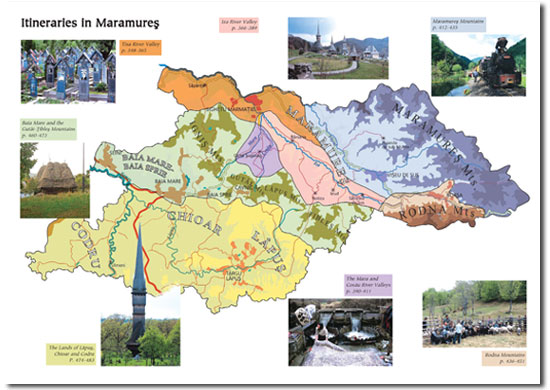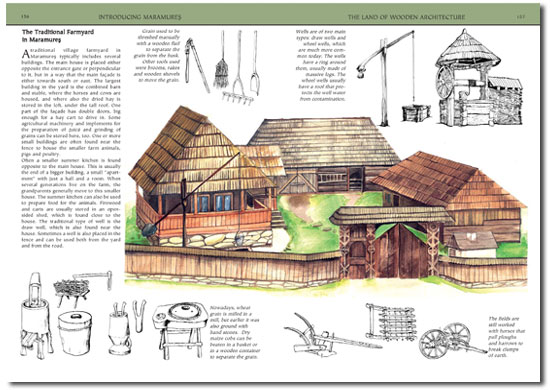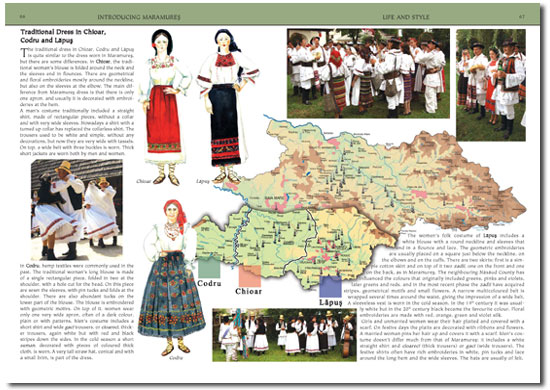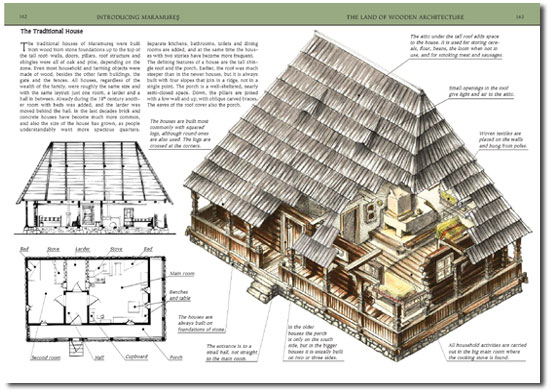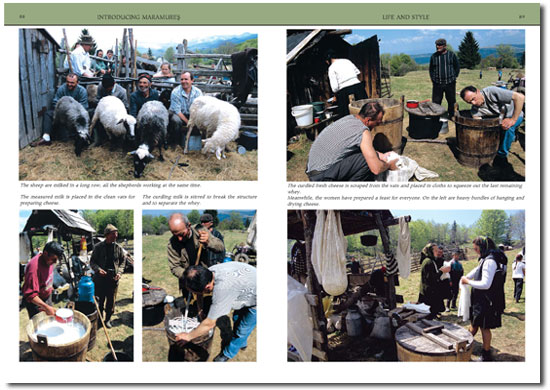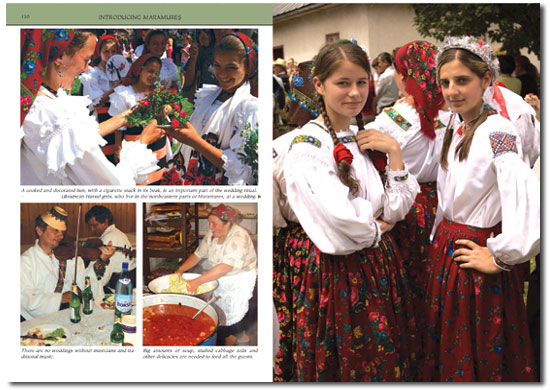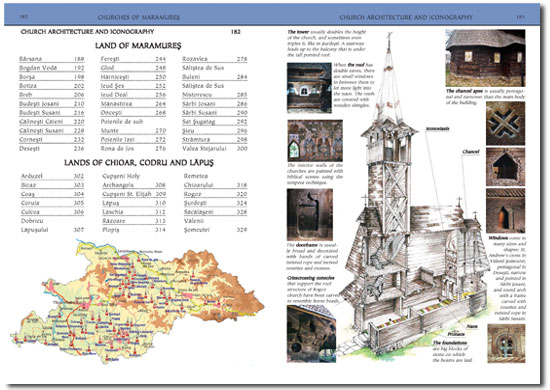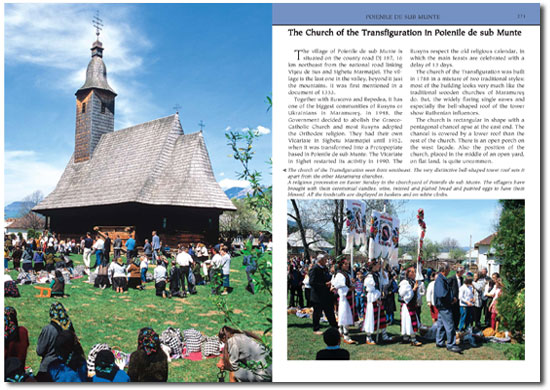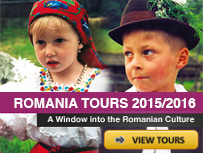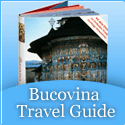Travel Guide – Maramures
{downloadpdfm}
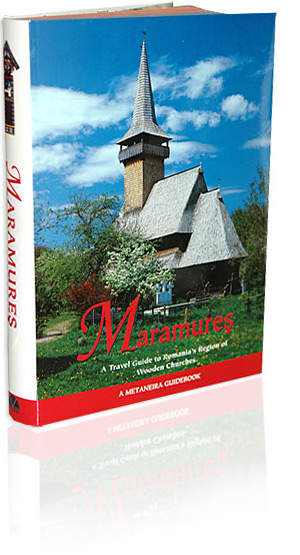
502 pages
750 color photographs
100 colour and black and white drawings
24 maps
Published by Metaneira in 2007
Price 24.99 €
Inside Maramures Guide
Buy Maramures Guide
{downloadpdfm}
The whole Maramureş region is a living “outdoor museum” famous for its unchanged way of life and for its well-preserved wooden villages and churches. It is perhaps one of the better-known regions of Romania – but still not much travelled. Our guidebook under preparation focuses on the famous wooden churches, UNESCO World Heritage sites, built during the 18th and 19th centuries. Besides describing each church in its own chapter, the book will have extensive chapters on the geography, history, traditional life, and religion of the region. Also practical information, such as when to go to Maramureş, what to see, and where to stay, will have its own chapter.
The book is of very high quality, with unique photographs. What you have seen on our pages on this site is a sample of what you will see in the book.
Buy Maramures Guide
Inside Maramures Guide
Travel to Maramures
There are many regions in this world that are worth a visit, and very often we Europeans tend to travel overseas to see something exotic, or visit people who still lead a life that perhaps our grandfathers knew. Rarely it occurs to us that it is not always necessary to travel far to be able to experience “time travel”.
Maramureş in northern Romania is one such little known corner of Europe. Amid beautiful rolling hills and lush river valleys live people who for the most part still follow the traditional agrarian way of life. Their life might seem hard and simple – and it is – a millenarian fight against the weather, to grow the crops, to raise the animals, to work from dawn until sunset without the many mechanized and electronic comforts we think are essential. But, that life can be rewarding in all its simplicity, as each day shows the results of work, and family and friends guarantee that there are often reasons for celebration. The seasonal festivities, like Christmas and Easter or local festivals and weddings, have retained their real value of breaking the everyday routine, and feasting lasts several days and is done with gusto.
The people of Maramureş, the moroşeni, are very hospitable, always ready to invite visitors to their homes, to offer a glass of horincã, the local distilled drink, made of plums or apples. Their hospitality is famous, as is their willingness to socialize with friends, but also visitors. This makes Maramureş an “easy” and interesting place to visit, but also the fact that the people have maintained their traditions maybe better than any other group in Romania, still wearing the folk costume, weaving textiles, carving wooden objects, and so on.
The traditional village was all built of wood, all houses, sheds, shelters, fences, gates and churches with their roofs of shingle. There are still some very well preserved villages that live in an organic harmony with the surrounding nature, the fields, the pastures, the meadows, the orchards and the forests. Today, many of the buildings are made with bricks, blocks and concrete, the roofs of corrugated iron. Fortunately, the scale of building is still small, and the structure of the villages hasn’t changed in time. And, if nothing else, at least the tall gates are still carved and raised before the houses as ever.
Why is the region considered unique and those who have been there want to return? The answer is a mixture of three things: amazing landscapes, genuine people and the simple civilization of wood, with the famous wooden churches whose towers can be seen from far. The nature, people, houses and churches are spiritually connected and have maintained this link to the present.
We had therefore plenty of reasons to choose the land of Maramureş for our second volume in a series of guidebooks dedicated to areas where people and cultural and natural heritage are equally worth a visit.
Why a guidebook and not another type of book? Because we consider that a cultural guidebook addresses those who, while enjoying a memorable holiday, can also help such a special region develop and maintain its specificity and character. To assure the preservation regions like Maramureş, it is necessary that they do not fall into total oblivion. It is necessary that the young people can remain, find work and live there with their families, while being at the same time aware of the importance of their inheritance. Cultural tourism can be a mutual investment that can bear fruit for everyone. The visitor’s joy and the host’s joy are both real experiences.
The guidebook is thematically structured into several chapters: Geography, History, Life and Style, Architecture, Wooden Churches, Itineraries along the River Valleys, and Practicalities.
Geography tells about the main geo-physical features of the region, as well as statistical data regarding population, surface, density etc, and information about the fauna and flora.
History presents the evolution of the people living in Maramureş since times immemorial up to modern times, with a stress on the mediaeval times, the voivodate, and on the fact that it managed to maintain its autonomy throughout the centuries. Special attention is also given to modern and contemporary history, with the presentation of the strange fate of the region at the end of World War I when about two thirds of the region was lost, and to the communist period when this was one of the most important centres of resistance.
Life and Style presents the traditional ways of living, which are still alive in this region that can be called a living museum.
Architecture tells how both the houses and the churches were built, how the house is structured, and how the wooden parts are decorated with carvings.
Wooden Churches describes nearly 30 churches in historical Maramureş and the neighbouring countries of Lăpuş and Chioar. Each church is portrayed on its own pages with photos of the exterior and the interior.
Itineraries includes a series of journeys on each main river valley, as well as information about hiking, trekking, canoeing and other sports.
Practicalities provides useful information as for what to eat and where to eat, where to sleep, with indicative prices and addresses. Hotels exist only in bigger towns, but there are private pensions and rooms where tourists can stay in the villages, and finding accommodation is not a problem. Maps of the area will show the most interesting places to visit. There is also a short glossary of Romanian language in the travel guide.
We hope that you will enjoy your travel to Maramureş!
We accept payments through PayPal. PayPal makes buying products and services or even sending money as easy as sending emails. It is the leading online payment system in the world. Fast, Easy and Secure!
You don’t need a PayPal account. Pay securely using your credit card.
If you don’t have a credit card and want to order the book, please contact us at order@romanianmonasteries.org.
We will try to find a different way to send you this beautiful book.
Price 24.99 €+ shipping and handling.
For purchases made in US dollars or other currencies they will be converted automatically in euros.
Questions about the order process? Please do not hesitate to contact us:
Tel: + 40-753-608318
“We returned from our two-week stay in Maramures and Bucovina two days ago. I wish to once more thank you for your guides; they proved to be an invaluable help in understanding the paintings in Maramures churches and Bucovina monasteries, but also a way to communicate with local people.
Sometimes in Maramures, when we could not find a church and showed its photos in your book to local people, they would take the guidebook, leaf through it, and with great excitement discover their friends and neighbors, and even themselves on the photographs… This opened quite a few doors to us – in the literal sense, doors to locked bisericas, but also to the world of the village people. Once we even got invited to a local wedding!”
Barbara Gadomska
“Yesterday, I received the Maramures book. Thank you very much for the swift handling of my order.
Please allow me to congratulate you and your publishing house with this outstanding travel guide. I‘m sure it will provide me many, many hours of reading and re-experiencing my recent trip to Maramures.
To me, it seems like an incredible effort to compile this kind of elaborate, detailed and wonderfully designed guide –– especially with a relatively small group of contributors. It must have been a multi-year labour, I assume, but it’s still very much up-to-date, which I find remarkable for a guide on a region that’s experiencing rapid changes.
Again, thanks a lot. I wish I had your guide before I went to Maramures, but unfortunately, for some reason I didn’t hear of it’s existence before. It was only when I talked to the director of the Maramures tourist agency in Sighet, that she showed me this book.
By the way: I can’t believe that you’ve produced a similar book on Bucovina. We planned to visit that region, too, but because of heavy floods we had to postpone that.”
Best regards,
Pancras Dijk, writer, text editor
National Geographic Magazine Nederland*België
““Maramures” is an excellent book, a rare mixture of proficient information, flowing descriptions, wonderful illustrations, everything based on a great concept. One can feel the love for this land coming out from every word from this book. Congratulations!
I have accidentally come across this book and everyone should know that this book is not just a traveling guide. “
I give you my best thanks,
Prof. Dr. Eike Uhlich
